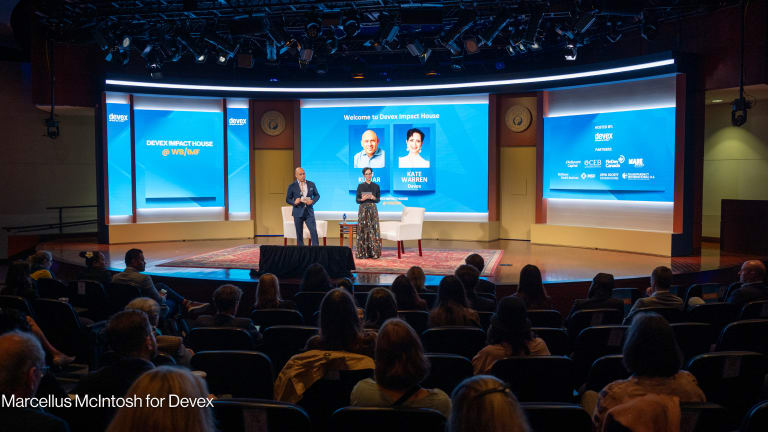
The pressure on the development sector to improve the ways in which it defines, captures and articulates contribution to development presents unique challenges — as well as opportunities — for development organizations working with volunteers.
The importance of how we define this contribution not only affects the way we design, implement and review development programs. It also provides an opportunity to ensure that the policy environment at national, regional and international levels recognizes and supports the role of volunteering in contributing to sustainable development.
I’ve been lucky enough, first as a volunteer and now through my involvement in Valuing Volunteering, a participatory research project with volunteers across the globe, to gain firsthand insights into how, where and when volunteering can contribute to sustainable change. This research has begun to make me think differently about how we define and measure the value of these volunteering interventions.
Understanding the context and complexity of volunteer interventions
The focus of measuring the contribution of volunteering to development has traditionally been on improving how we measure and demonstrate the quantifiable. This tends to lead us to the following equation: You measure your input — the time, skills and knowledge of the volunteer — against your output, or the number of individuals impacted as a result of the work the volunteer has contributed to.
It paints a very neat and linear picture of the route to change, but we know that change is specific to a particular context, never linear and almost always complex. For example, people’s perceptions of volunteering can influence whether or not individuals in the community are willing to trust in the support and advice the volunteer is there to provide.
If we could develop a better understanding of some of the contextual factors that support or limit the volunteer’s activities — such as local perceptions of volunteering — we stand a better chance of identifying ways to strengthen our impact.
Unpacking the specific attributes of volunteering
Measuring only volunteer contribution as quantifiable inputs and outputs implies that the main attribute of volunteering lies in the skills and knowledge being provided by the volunteer. But teachers working alongside international volunteers in the far western region of Nepal, for example, commented that often the technical knowledge and skills of the volunteer were secondary to the way in which they and the volunteers worked together.
“We already had the ideas in ourselves, but we weren’t using them … At first the teachers feel shy, there’s a lack of confidence. But after some time, their confidence grows,” said a head teacher in Dhangadhi, Nepal.
One teacher described the volunteers as “very close, like family.” The time the volunteers spent living and working alongside their colleagues, ranging from several months to more than a year, meant that they got to know, trust and understand each other. It allowed for the volunteer to act as a facilitator, helping the teachers to translate their own ideas into practical actions.
The real added value of volunteering is therefore not only what the volunteer brings in terms of skills, knowledge and new ideas, but how they interact with people and transfer knowledge. The most successful and sustainable transactions are reciprocal and not led purely by the expertise of the volunteer.
“What I learned is that volunteering is really a partnership,” said a student volunteer at Miriam College in the Philippines. “It is not that you go and are superior. You learn as much from them.”
Volunteering contributes to change by building human and social capital, strengthening people’s confidence in their own knowledge and skills, reinforcing community networks and supporting individuals to take ownership over identified ideas and solutions. It is only then that these solutions and ideas are sustained in the long term.
The commitment to implementing a people-centered post-2015 framework presents an opportunity for us to ensure that the role of volunteering is recognized as a means of facilitating a bottom-up approach that values citizen ownership over change.
Changing the way we think about and measure volunteering
So what does all this mean for how we define and measure the contribution of volunteering?
The difficulty, if we look first at measurement, is finding a balance between capturing and evaluating the hard data as well as the “soft” outcomes. Both approaches require time, thought and resources, but pressure — by donors, governments and taxpayers — is often placed on the development sector to prioritize demonstrating development results against the costs involved and the resources — in this case, volunteers — provided. Arguably, however, it is not just about dedicating more time and resources to capturing the harder-to-measure attributes, but starts with how volunteering is integrated into our development approaches in the first place. If we know, for example, that one of the strengths of volunteering is the ability to be responsive and reflexive according to the needs identified, then our programs need to allow for this.
Based on what VSO has learned from the Valuing Volunteering research and interactions with volunteers and partners or communities working with volunteers, the following are just some of the implications we’ve begun to identify for how we design, implement and review programs as well as influence policy that truly captures the added value of volunteering:
1. Ensure that all participants are active partners in the design, implementation and review of projects working with volunteers
By engaging all participants involved in a project or program, particularly local partners and individuals in the community, in the process of reflecting on and reviewing how change happened and the role of volunteering, we can begin to build a more accurate, bottom-up picture of where and how volunteering contributes to change.
2. Build in the time and space for reflection
In order to capture learning consistently and allow volunteering to be responsive to changing needs and contexts, we have to create spaces and allow the time for reflection and review within development projects involving volunteers.
3. Develop indicators that capture the soft outcomes
If the indicators that have been set by volunteering for development organizations, a donor or policymaker do not capture the soft outcomes that we want to measure in order to understand our contribution to change, we need to develop indicators that will allow us to do this and find new and creative ways of gathering this data.
4. Advocate for recognition of the contribution of volunteering within national policy and the post-2015 framework
Volunteers are an important means by which any development goal framework will be implemented and extended to some of the poorest and most marginalized groups, yet their contribution often remains largely unrecognized. VSO and other volunteering for development organizations are calling for a post-2015 framework that recognizes, effectively supports and measures the role that volunteers can play in facilitating people-centered, sustainable development.








